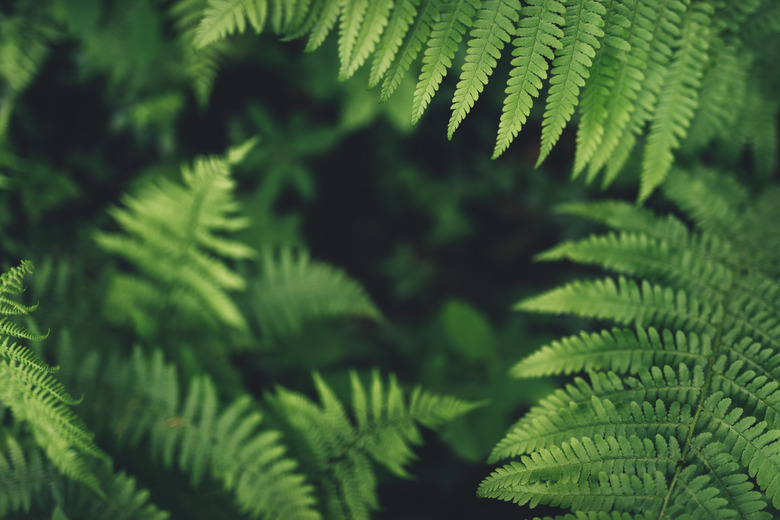Characteristics Of Seedless Vascular Plants
Vascular plants are also called Biology(OpenStax'>tracheophytes/5%3A_Biological_Diversity/25%3A_Seedless_Plants/25.4%3A_Seedless_Vascular_Plants), and this group includes both seedless and seed-bearing species. The term vascular seedless plants refers to land plants that have conductive tissue – such as xylem and phloem – but do not flower or produce seeds.
Three types of vascular plants that are not seed-bearing are ferns, horsetails and club mosses. There are several common characteristics of plants in this group, including the presence of vascular tissue, roots and leaves.
Seedless Vascular Plants Examples
Seedless Vascular Plants Examples
Examples of seedless vascular plants include both living and extinct species. Species in this group that are extant – or living on the planet today – belong to two phyla: Lycopodiophyta and Monilophyta.
The phylum Lycopodiophyta is commonly referred to as the club mosses. Small in size like true mosses, the club mosses are thought to be some of the oldest seedless vascular plants. There are about 1,200 species of club mosses.
Other seedless vascular plants belong to phylum Monilophyta. Within this phylum, there are two classes of seedless vascular plants: Equisetopsida and Psilotopsida.
Class Equisetopsida refers to the horsetails. While diverse examples of this class exist in the fossil record, extant species of this class belong to only one genus, _Equisetum_.
There are two groups within class Psilotopsida: ferns and whisk ferns. Ferns have large leaves, or fronds, while whisk ferns do not have leaves. There are more than 10,000 extant species of ferns, while only two species of whisk ferns are currently in existence.
Vascular Tissue, Roots and Leaves
Vascular Tissue, Roots and Leaves
Seedless vascular plants have several common traits, including the presence of roots, leaves and vascular tissue. Another common characteristic of this group is that the diploid sporophyte is the most prominent phase of the life cycle.
Botanists believe that vascular tissue originated in plants around 430 million years ago. Vascular tissue consists of xylem for transporting water and phloem for moving sugars. Because the cells of xylem and phloem are rigid, vascular tissue also allows some tracheophytes to grow much taller than nonvascular species.
Seedless vascular plants also have roots, which are structures that anchor them to the soil. Besides keeping plants in place, roots also increase the surface area of the plant that is in contact with the soil, increasing opportunities for absorbing moisture.
The development of leaves is an adaptation that has been dated to about 350 million years ago. Ancestors of seedless tracheophytes like mosses have phyllids, which are small leaflike structures, but true leaves appeared in plants with the development of vascular tissue.
The larger size of true leaves helps seedless vascular plants like ferns capture more sunlight, which is another reason that some seedless vascular plants are able to grow larger than their nonvascular ancestors – more sunlight equals more photosynthesis, which means more food to support a larger plant.
Evolution of Seedless Tracheophytes
Evolution of Seedless Tracheophytes
Scientists believe that seedless vascular plants evolved from bryophytes, which are primitive plants like mosses, hornworts and liverworts. Bryophytes lack vascular tissue, true roots and leaves, which are adaptations that originated with the seedless tracheophytes.
However, one trait of the bryophytes that is also present among the seedless vascular plants is a dependence on water for reproduction. The sperm of ferns, horsetails, whisk ferns and club mosses requires a layer of water on the leaves of the plant to reach and fertilize an egg.
Because they have vascular tissue to provide support and structure, plants like ferns and club mosses are able to grow much larger than their ancestors, the bryophytes. Roots, vascular tissue and leaves make it possible for one species of fern, the Norfolk tree fern, to grow over 60 feet in height.
Cite This Article
MLA
Sloane, Christina. "Characteristics Of Seedless Vascular Plants" sciencing.com, https://www.sciencing.com/characteristics-of-seedless-vascular-plants-12255836/. 30 September 2021.
APA
Sloane, Christina. (2021, September 30). Characteristics Of Seedless Vascular Plants. sciencing.com. Retrieved from https://www.sciencing.com/characteristics-of-seedless-vascular-plants-12255836/
Chicago
Sloane, Christina. Characteristics Of Seedless Vascular Plants last modified March 24, 2022. https://www.sciencing.com/characteristics-of-seedless-vascular-plants-12255836/
